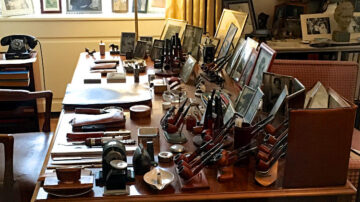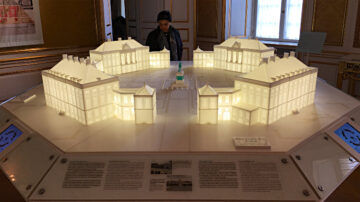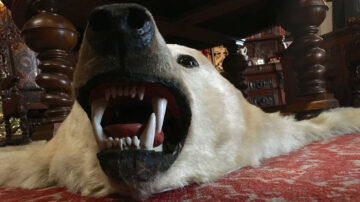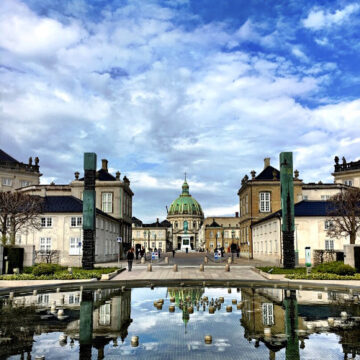The museum in Amalienborg Palace is a popular sight to see in Copenhagen – a visit covers the royal history of the Danish constitutional kings and queens.
The Amalienborg Palace complex in Copenhagen is the official residence of the Danish monarch. Two of the four Amalienborg rococo palaces are open to visitors. The Amalienborg Palace Museum (Amalienborgmuseet) is in the Christian VIII palace and comprises mostly the studies of the kings of the past century and a half, as well as some of the original neoclassical representation rooms of Amalienborg. The representation rooms that are still in use in the adjacent Christian VII palace may be seen on guided tours but for this part of the palace, reservations are essential.
The Amalienborg Palace Museum

The Amalienborg Palace Museum gives an overview of royal life and palace interiors of mostly the constitutional monarchs of Denmark since 1849. The period of the absolute monarchy from the 17th to 19th centuries is comprehensively covered in the very popular Rosenborg Castle elsewhere in Copenhagen.
The museum is spread over two floors in the Christian VIII Palace – it is seen without a guided tour. The first floor has mostly reproduced studies of the various monarchs while a visit to the upper floor includes some of the representation rooms that were designed when the royal family unexpectedly had to move into the Amalienborg Palace at the end of the 18th century. A peak into the royal attic is also surprisingly interesting.
See the Amalienborg Palace for more on the palace complex and the changing of the guard ceremonies.
Royal Studies in the Amalienborg Palace
The main attraction of the Christian VIII Palace in Amalienborg is the studies of the various monarchs. These were reproduced largely in the same spaces as the originals were in the adjacent palaces where the kings lived.
The Study of Frederik IX (1947-72) confirms his naval background and love of music. It also shows an enormous collection of pipes – even to the present day, the queen and most of the Danish royal family are heavy smokers (although the last couple of years they’ve mostly refrained from doing so while video cameras are running).
The Study of Christian IX (1863-1906) is typical Victorian with many items but most noticeably a large collection of family photos – a new and expensive – status symbol at the time. It also confirmed his status as Europe’s father-in-law given that six of his children married into other European ruling royal families.
His wife, Queen Louise, had an equally busy salon that left no space unadorned.
The Garden Room is the largest room on the ground floor and the only one in the palace with its original rococo ceiling. However, few visitors look up, as the room is dominated by a large interactive scale model of the Amalienborg complex.
The Dining Room with its golden walls is mostly turn of the century and was in use during the first half of the 20th century.
The Study of Christian X (1899-1947) is the most authentic of all the royal studies on show, as it is not a recreation but the original. It is a dark room with heavy furniture and with a large collection of sabers and guns.
The Costume Gallery has a changing exhibition of royal dresses and uniforms.
The Study of Frederik VIII (1906-1912) was furnished during the 1860s in Renaissance Revival style – heavy furniture and fake golden leather on the walls. The polar bear skin hints at Denmark’s rule over Greenland. (For similar reasons, polar bears feature on the roof of Copenhagen’s town hall.)
The Golden Cage is a small treasury with some royal jewels and bejeweled objects by artists as famous as Fabergé and Jerichau – the real treasury and Danish crown jewels are on display in the Rosenborg Castle.
Representation Rooms in the Piano Nobile
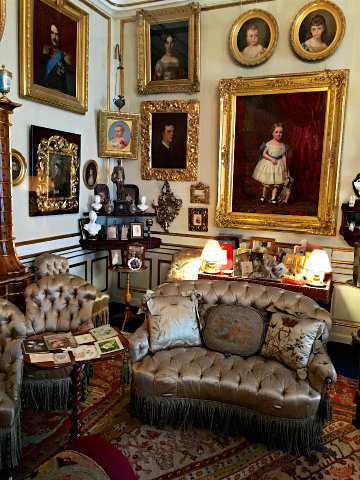
Some of the most beautiful rooms in the Amalienborg Palace are the representation rooms on the piano nobile – these are still sometimes used by minor royals. The neo-classical interiors are mostly to the designs of Nicolai Abraham Abildgaard, who renovated the Amalienborg palaces for the royal family that moved here after the Christiansborg burnt down in 1794.
Many of the rooms here were specifically designed for Hereditary Prince Frederik (1753-1805), who acted as regent for his half-brother Christian VII from 1772-1784. However, Hereditary Prince Frederik had no royal powers during the Amalienborg period, although three years after his death his son succeeded to the throne as King Fredrik VI.
The Gothic Library was made for Dowager Queen Caroline Amalie in the mid-19th century. It is considered the only complete neo-Gothic room in Denmark – the style so popular in much of Europe never caught on here.
The Pompeian Chamber is painted in the style popular after the rediscovery of Pompeii. Christian Købke was one of the painters.
The shiny Throne Chamber was designed for Hereditary Prince Frederik but was never used.
The Apartment Hall has a Golden Tableau with gilt bronze copies of works of Bertel Thorvaldsen – his full oeuvre is displayed in the Thorvaldsen Museum at the Christiansborg Palace complex.
The Gala Hall is the largest room in the palace. This neo-classical room designed by Abilgaard is one of the most accomplished interiors in Denmark. The statues and the friezes are by Thorvaldsen. The massive Norwegian chandelier was only hung in the room early in the 20th century – two similar ones are in the Christiansborg while the Norwegian royals have to make do with modern copies in the palace in Oslo.
In the attic, visitors may see the royal storage rooms with articles ranging from chamber pots to royal gifts, orders, luggage, surplus busts, bicycles, and toys.
Amalienborg Palace Museum Visitor’s Information
Opening Hours of the Amalienborg Palace Museum
The Amalienborg Palace Museum in the Christian VIII Palace is generally open from 10:00 to 16:00 but small changes in the opening hours are frequently made.
The palace is closed most Mondays from November to April but may be open on holidays and during school vacations.
The Amalienborg is closed over Christmas but is open over New Year’s with extra long hours on January 1.
Tickets for the Amalienborg Palace Museum
Tickets for Amalienborg Palace are DKK125 for adults, free for children under 18, and DKK65 for students.
A combination ticket with Rosenborg Palace that is valid for 36 hours is good value at DKK200. (Queues for tickets at Amalienborg are usually much shorter than at Rosenborg.)
Discounts are given if touring Christian VII’s palace on the same day – see below.
Admission to Amalienborg is included in the Copenhagen Card but pass by the ticket counter first.
Amalienborg is wheelchair accessible but strollers and prams must be left at the entrance.
Taking photos are not only allowed but actively encouraged.
Visit the Amalienborg Palace of Christian VII
The Palace of Christian VII at Amalienborg is the representative and guest palace of the Danish royal family. It is still being used and may only be seen on guided tours – reservations are essential.
Guided tours in English of the Palace of Christian VII are generally around 13:00 on Thursday to Sunday and takes just over an hour. No bags or photography is allowed – use the lockers (and toilets) at the Christian VIII palace.
The ticket for Christian VII’s palace is DKK105 per person. Bearers of these tickets may see Christian VIII’s palace on the same day for DKK65 (or DKK125 if Rosenborg Castle is added).
See also the Amalienborg Palace complex for more on the official Copenhagen residence of the Danish monarch and the daily changing of the guard ceremony.

